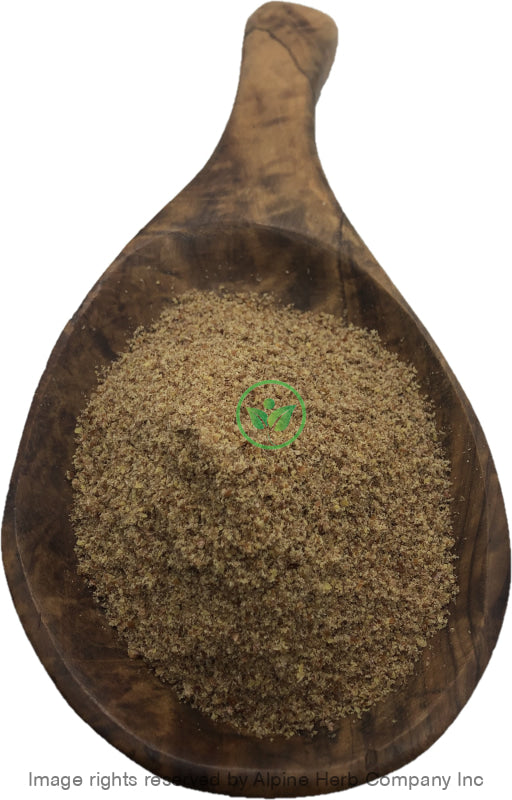Flax Seed Powder (Brown) Alpine Herb Company Inc.
$ 3,99 $ 2,39
Botanical Name: Linum usitatissimum
Common Name:
- English: Lin seed
- Ayurvedic: Atasi, Umaa, Masrnaa,Nilapushpi, Kshumaa
- Unani: Kattan
- Also, known as: Alshi, Arasi, Alsi, Agasebeeja, Semeagare, Agasi, Katan, Avisa, Ali, Virai, Atushi, Uma, Ksuma, Tisi, Tusi, Masina, Agastha, Agasi, Cheru charm, Atshi, Sirrali, Flachs, Lin, Lino usuale, Hu-ma-esze, Tesimosina, Bazen
Habitat: Uncertain (It has been cultivated from before recorded history).
Origin:
Harvested: Cultivated
Parts Used: Seed
General Information:
It has been cultivated in all temperate and tropical regions for so many centuries that its geographical origin cannot be identified.
Linum usitatissimum is an erect annual herb, growing to 2 feet by 1 feet. Seed small, brown, glossy with the minutely pitted surface, about 4-6 mm long and 2-2.5 mm in maximum width, flattened, rounded at one end and obliquely pointed at the other. The flowers have both male and female organs) and are pollinated by Insects. The plant is self-fertile. Flax blossoms have five petals and are usually blue, but can also be bright red. After the flowers have died, flax bears a fruit that is round dry capsule less than a centimeter in diameter. Each capsule contains several seeds that resemble small apple seeds.
Flax seeds are one of the world’s renowned superfoods. These seeds are very nutritious and helping in several health conditions. They are very rich in Omega-3 essential fatty acids. Flax seeds also contain a good amount of dietary fiber and Limnanthes seeds, which are high in fiber and mucilage, absorb large amounts of fluid and draw out toxins when ingested and act as a gentle bulking laxative. The seeds are used whole or crushed. Linseed varies much in size and tint – a yellowish variety occurring in India. Holland, Russia, the United States, Canada, the Argentine, and India furnish the principal supplies.
Flaxseed oil is extracted by pressing the seeds. Only cold-pressed oil is used as food and herbal medicine. Flaxseed oil is well-known for its high content of essential fatty acids. These fatty acids are only accessible if the seeds are split prior to ingestion.
Throughout history, flax has been used to maintain the health of animals. Farmers have reported that pregnant cows fed flaxseed gave birth to healthier calves. When flaxseeds are added to the diets of pets, their fur coat improves.
Flax is grown for its oil, used as a nutritional supplement, and as an ingredient in many wood-finishing products. Flax is also grown as an ornamental plant in gardens. Flax fibers are used to make linen. The Latin species name usitatissimum means “most useful”.
How to use:
Powdered Herb:
As a food supplement.
Food Preparation: You can add powdered herbs to any super food, herbal smoothie, sauces, spreads and even cookies. Also for children, you can mix powdered herbs with honey or glycerin to make a paste. The thicker the paste, the more potent and herbal in taste. The sweet taste of honey and glycerin will help the medicine go down. This method is also known as “Electuaries”.
Precautions:
You should consult with a qualified healthcare practitioner before using any herbal products, particularly if you are pregnant, nursing, or on any medications.
All information on this website is for educational purposes ONLY.
This information has not been evaluated by Health Canada.
This information is not intended to diagnose, treat, cure, or prevent any disease.
| Unit Size | 100g, 200g, 400g, 1kg |
|---|
Prompt shipping and expert packing
Thanks to our longstanding association with UPS FedEx DHL as well as other leading global carriers, we can offer a variety shipping options. Our warehouse staff is highly trained and will be able to pack your goods in accordance with our precise and exact specifications. Your items will go through an exhaustive examination before they will be securely packaged before being delivered. We ship to hundreds of thousands of customers daily in different countries. This is a sign of our determination to become the largest online retailer worldwide. Warehouses and distribution centers are located throughout Europe as well as in the USA.
Note that orders containing multiple items are processed according to the particular item.
We will thoroughly inspect all items ordered before shipping. Most orders are shipped within 48 hours. The delivery time will be between 3 and 7 working days.
Returns
The stock market is always changing. It's not entirely managed by us since we're involved with several entities, including the factory and the storage. Therefore, the actual inventory could fluctuate at any moment. Please be aware that it is possible that your order could be out of stock after you've placed your order.
Our policy lasts for 30 days. If it's been more than 30 days since the date you purchased your item We're sorry to say that we can't offer you a full exchange or refund.
You can only return a product if it is unused and still in the same state as when you received it. The item should be in the original packaging.
Related products
Herb Powder
Herb Powder
Herb Powder
Herb Powder
Herb Powder
Herb Powder
Herb Powder
Herb Powder
Herb Powder
Herb Powder
Herb Powder
Herb Powder
Herb Powder
Herb Powder
Herb Powder
Herb Powder
Herb Powder
Herb Powder
Herb Powder
Herb Powder


































